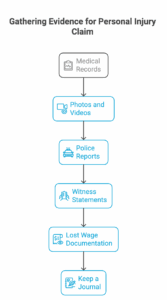Dealing with a personal injury can be overwhelming. Where do you even begin? This guide breaks down the essentials, offering insights into common claims, legal deadlines, and how to handle insurance companies.
Understanding the Basics: What is a Personal Injury Claim?
A personal injury claim arises when you’re hurt due to someone else’s carelessness or intentional actions. Think of it as seeking compensation for the harm someone else caused you, covering things like medical bills, lost income, and pain and suffering. The core concept is proving that another party’s negligence directly resulted in your injuries.
Common Personal Injury Cases: From Car Accidents to Slip and Falls
Personal injury claims come in many forms. Here are some of the most frequent:
- Car Accidents: Sadly, very common. These often involve proving fault – showing the other driver violated traffic laws or was otherwise negligent. For instance, distracted driving is a major contributor. The National Highway Traffic Safety Administration (NHTSA) estimates distracted driving led to over 3,100 fatalities in 2020 alone. Settlements often consider vehicle damage, medical costs, and lost wages.
- Slip and Falls: Property owners have a duty to keep their premises safe. If they fail to do so, and you’re injured by a hazard like a wet floor or broken stairs, you may have a claim. A recent case in California involved a shopper who received a $75,000 settlement after slipping on spilt produce in a grocery store.
- Medical Malpractice: This occurs when a healthcare professional’s negligence causes harm to a patient. Examples include surgical errors, misdiagnosis, and medication errors. These cases are complex and require expert testimony.
- Dog Bites: Many states have strict liability laws regarding dog bites, meaning the owner is responsible for injuries even if the dog has never bitten anyone before.
- Defective Products: If a product is dangerously designed, manufactured, or marketed, and it causes injury, the manufacturer can be held liable. Several high-profile cases involve defective medical devices and dangerous drugs.
Time is of the Essence: Statutes of Limitations for Personal Injury Claims
Don’t delay! Every state has a statute of limitations, which sets a deadline for filing a lawsuit. Miss this deadline, and you lose your right to sue. Here’s a general overview:
- General Personal Injury: Most states have a statute of limitations of 2-3 years from the date of the injury.
- Medical Malpractice: The statute of limitations may be shorter, often around 1-2 years, and may have different rules based on when the injury was discovered.
- Claims Against Government Entities: These claims often have significantly shorter deadlines, sometimes as little as six months.
Example: Let’s say you were injured in a car accident on January 1, 2023, and your state has a two-year statute of limitations. You must file your lawsuit by January 1, 2025.
Navigating the Insurance Maze: Common Tactics and How to Respond
Dealing with insurance companies can be tricky. Remember, their goal is to minimise payouts. Here are some common tactics and tips for responding:
- Lowball Offers: Expect the initial offer to be lower than what you deserve. Don’t accept it without consulting an attorney or understanding the full extent of your damages.
- Delaying Tactics: Insurance companies may delay processing your claim to pressure you into accepting a lower settlement.
- Requesting a Recorded Statement: Be cautious about giving a recorded statement without consulting a lawyer. What you say can be used against you. Stick to the facts.
- Denials Based on “Lack of Evidence”: This is common. That’s why thorough documentation is crucial (see below).
How to Respond: Be polite but firm. Document all communication. Don’t be afraid to negotiate. Seek legal help if needed.
Building a Strong Case: Evidence and Documentation for Your Personal Injury Claim
Evidence is your best friend. Gather as much as possible:

- Medical Records: Document all medical treatment, diagnoses, and expenses.
- Photos and Videos: Take pictures of the accident scene, your injuries, and any property damage.
- Police Reports: Obtain a copy of the police report for car accidents or other incidents.
- Witness Statements: Get contact information from witnesses and ask them to write down what they saw.
- Lost Wage Documentation: Keep track of lost income due to your injuries. Get a letter from your employer.
- Keep a Journal: Document your pain, limitations, and emotional distress. This helps illustrate the impact of the injury on your life. Emotional distress damages can be a significant part of a settlement.
Beyond the Basics: When to Seek Legal Advice for Your Personal Injury Claim
While some minor claims can be handled independently, legal counsel is highly recommended in certain situations:
- Serious Injuries: Cases involving significant medical expenses, long-term disability, or permanent disfigurement.
- Disputed Liability: When the other party denies responsibility for the accident.
- Complex Legal Issues: Medical malpractice or product liability cases.
- Unfair Insurance Practices: If the insurance company is acting in bad faith.
An attorney can help you understand your rights, gather evidence, negotiate with the insurance company, and file a lawsuit if necessary.
Protecting Your Rights: Key Takeaways for Navigating Personal Injury Claims
- Document everything.
- Know your state’s statute of limitations.
- Be cautious when dealing with insurance companies.
- Don’t hesitate to seek legal advice.
Understanding your rights and taking proactive steps can significantly improve your chances of a fair outcome.





